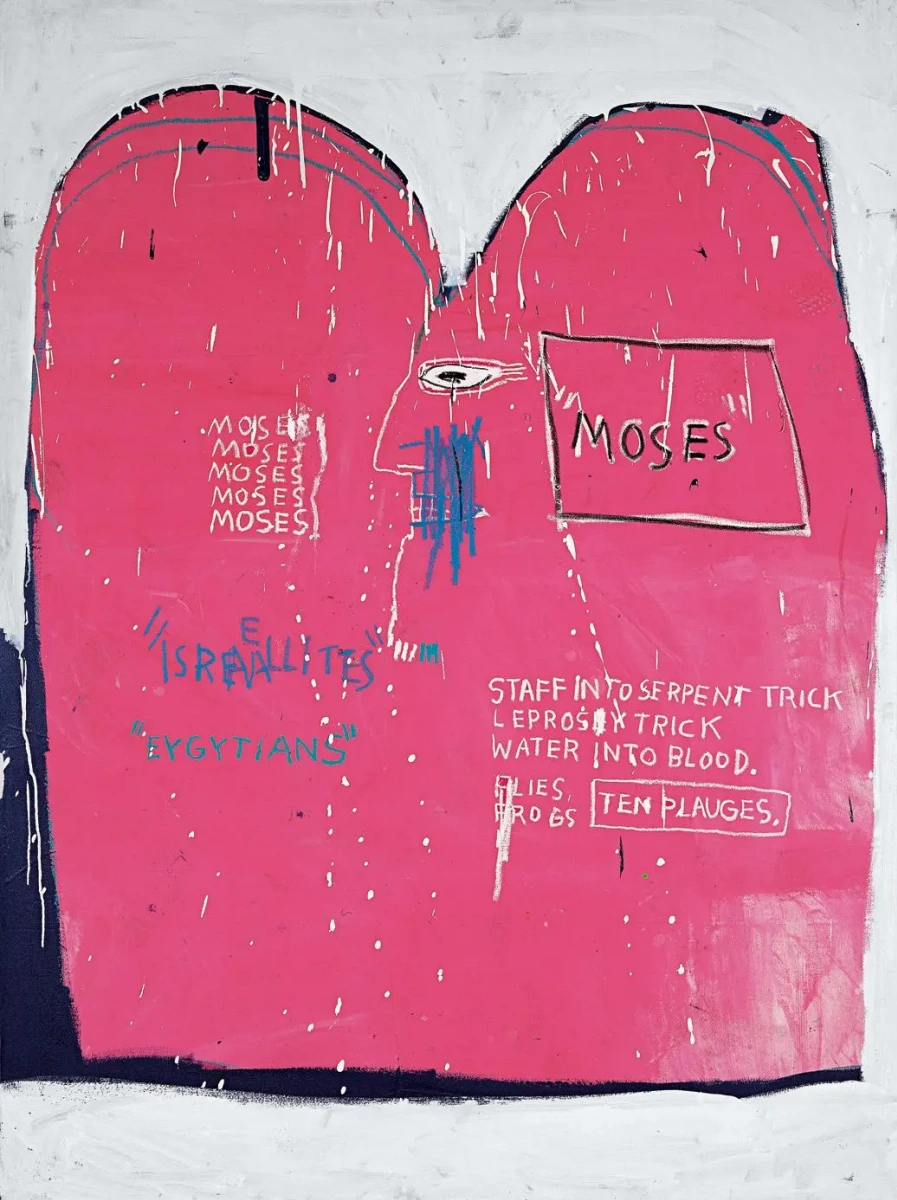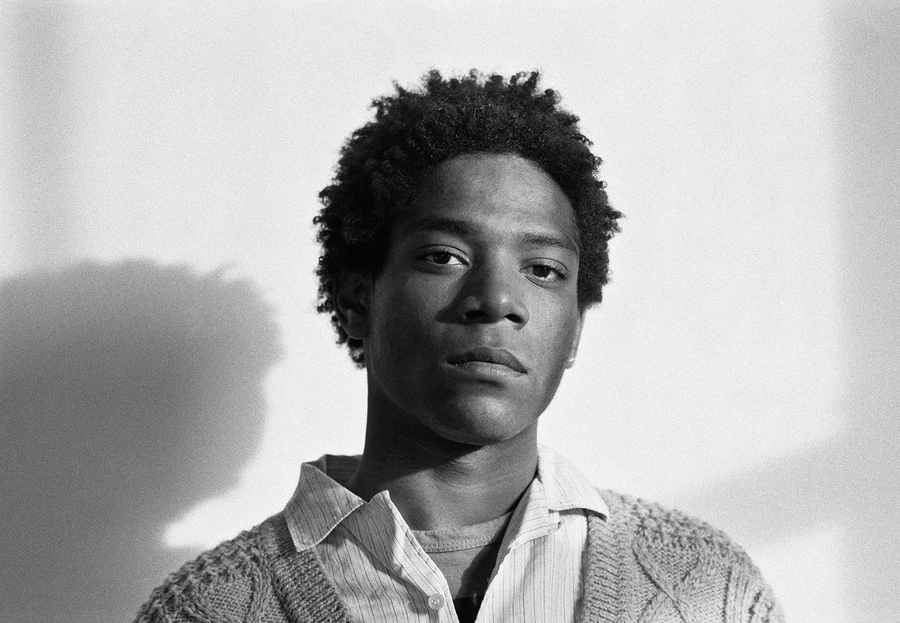Looking for a muse? Check no further. Discover the Best of Art, Culture, History & Beyond!

| Artist | Jean-Michel Basquiat |
|---|---|
| Title | Moses and the Egyptians |
| Year | 1982 |
| Medium | Acrylic and oil stick on canvas |
| Dimensions | 185.9 x 137 x 4 cm |
| Location | Guggenheim Bilbao |
In the early 1980s, Jean-Michel Basquiat emerged as one of the most groundbreaking artists of his generation. His works, often raw and unrefined, merged street culture, African-American identity, and an unflinching commentary on societal injustice. Among his vast collection of works, one stands out as a symbol of his ability to transform biblical narratives and social history into potent visual statements: “Moses and the Egyptians” (1982). A canvas brimming with symbolism, Basquiat’s iconic painting not only explores themes of liberation and oppression but also speaks to the broader African-American experience. Produced when Basquiat was only 20 years old, this piece is a powerful testament to his artistic prowess, his critical mind, and his foresight in confronting historical and political themes that still resonate today.
Moses and Egypt
At its surface, the title of the painting—“Moses and the Egyptians”—brings to mind one of the most enduring biblical stories: the tale of Moses leading the Israelites out of Egypt and into freedom. The story, immortalized in the Book of Exodus, is not merely one of divine intervention; it’s a story of resistance, oppression, and eventual liberation. Moses, acting as both a prophet and a leader, confronts the oppressive rule of Pharaoh, the Egyptian king, and leads the enslaved Israelites to freedom.
Basquiat’s choice to center his work on this biblical narrative, however, does not necessarily signal a straightforward religious commentary. Instead, it serves as a metaphor for liberation from historical and systemic oppression, especially oppression tied to the Black experience in America. In this context, the Egyptians can be interpreted as a symbol for the colonial and racist systems that continue to subjugate marginalized peoples, particularly African-Americans. Moses, on the other hand, takes on a more symbolic role of the revolutionary figure—the individual or collective leader capable of challenging these systems.
The influence of Black liberation movements—particularly during the late 1960s and 1970s—cannot be overlooked in this painting. The emergence of figures such as Malcolm X, Angela Davis, and Martin Luther King Jr. as symbols of resistance to white supremacy may have shaped Basquiat’s view of Moses as a modern-day liberator. In fact, the way Basquiat incorporates powerful figures into his art suggests a deeper connection to historical struggles against enslavement and injustice.
Between the Past and Present
While the title and visual elements of the painting clearly reference biblical history, the way Basquiat executes this work is thoroughly modern. The canvas, boldly painted with acrylics and oil stick, carries an intensity of expression typical of Basquiat’s work. His characteristic style, blending graffiti with figurative imagery and abstraction, serves not just as a visual language but as a means of confronting social and political realities.
In the painting, Moses is likely depicted as a central figure. Basquiat often used crowns as symbolic representations of both royalty and martyrdom—key themes for his understanding of Black empowerment. The figure of Moses may, therefore, be seen as a crowned king, a symbol of leadership, but also of sacrifice, resistance, and strength. The chaotic brushstrokes and frenetic energy surrounding the figure reinforce the tension and urgency of the historical moment depicted, suggesting that the battle between the oppressed and their oppressors is ongoing, unresolved.
The Egyptians, though not clearly depicted as individual characters, may be understood symbolically. Basquiat’s work often resists direct representation, preferring instead to create images that speak to a larger conceptual idea. Thus, the Egyptians in the painting may symbolize the oppressive forces—not necessarily tied to one geographic location or historical moment, but to a universal experience of power, control, and domination.
Basquiat’s use of text—words like “Exodus,” “Pharaoh,” and “slavery”—could serve to explicitly ground the painting in its historical context while also connecting it to the modern-day struggle for freedom and justice. The use of scribbled words also signals Basquiat’s constant re-evaluation of language and the written word—viewing it not just as a means of communication, but as an instrument of power and resistance.
Race, Power, and Liberation
To fully appreciate the gravity of “Moses and the Egyptians,” it’s crucial to contextualize Basquiat’s relationship to race and how this informs his work. As an artist of Haitian and Puerto Rican descent, Basquiat navigated a complex intersection of racial and cultural identity. Throughout his career, Basquiat confronted the power structures of the art world, the political landscape, and his own identity as a young Black man in America.

Basquiat’s depiction of Moses as a resistant leader is not merely symbolic; it’s a call to action. By invoking the figure of Moses, Basquiat suggests that liberation can come through revolution, whether spiritual, political, or personal. The painting, therefore, is not just a reflection of history, but a commentary on contemporary struggles. In the early 1980s, racial tensions were high, and Black communities were fighting for civil rights, representation, and justice. Basquiat’s art becomes a visual language of resistance, using the power of the past to challenge the injustices of the present.
The Egyptians may also symbolize colonial powers and white supremacy—systems of oppression that, while changing shape over time, continue to subjugate African-Americans in various ways. The oppression represented in the painting could be seen as reflective of modern racial inequalities, where those in power often continue to subjugate marginalized communities.
Basquiat’s work—especially this painting—says much about the necessity of questioning authority, about challenging systems of oppression, and about the potential for individuals (or communities) to reclaim their power.
Basquiat’s Context
The 1980s, when Basquiat created “Moses and the Egyptians,” was a period marked by significant political unrest. In the U.S., the Civil Rights Movement of the 1960s had led to substantial changes, but much work remained. The country was grappling with racism, economic inequality, and the remnants of segregation. Basquiat himself was deeply influenced by the Black Power Movement, which placed an emphasis on Black pride, unity, and resistance.
Furthermore, the period saw the rise of Reaganomics, which disproportionately impacted Black communities, and the emergence of the HIV/AIDS crisis, which affected both Black and LGBTQ+ communities. In this politically charged environment, Basquiat’s art became an act of defiance against the systems of control and exploitation.
By referencing Moses—the ultimate symbol of divine resistance—Basquiat draws a parallel between the biblical fight for freedom and the fight against modern racial oppression. This makes “Moses and the Egyptians” as relevant today as it was in the early ’80s.
In today’s world, where issues of race, political power, justice, and equality remain front-and-center in global conversations, Basquiat’s “Moses and the Egyptians” continues to resonate. The Egyptians, symbolic of oppressive forces, can be likened to today’s social and political structures—whether in the form of racism, nationalism, economic exploitation, or even geopolitical conflicts. The figure of Moses, as a leader and revolutionary, reminds us that even in the face of tremendous adversity, change is possible.
The way in which Basquiat’s works blend historical narrative with social critique makes them timeless. “Moses and the Egyptians” is a reminder that art has the power to provoke thought, spark conversation, and ultimately drive change.
By reimagining biblical history through the lens of African-American experience and liberation, Basquiat’s work speaks to a universal struggle against oppression—one that transcends both time and geography. In today’s world, the painting’s call for resistance, power, and liberation remains as urgent and relevant as ever.

This article is published on ArtAddict Galleria, where we explore the intersections of art, history, and culture. Stay tuned for more insights and discoveries!



